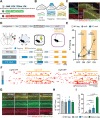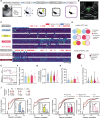This is a preprint.
Deconstruction of a memory engram reveals distinct ensembles recruited at learning
- PMID: 39713328
- PMCID: PMC11661170
- DOI: 10.1101/2024.12.11.627894
Deconstruction of a memory engram reveals distinct ensembles recruited at learning
Abstract
How are associative memories formed? Which cells represent a memory, and when are they engaged? By visualizing and tagging cells based on their calcium influx with unparalleled temporal precision, we identified non-overlapping dorsal CA1 neuronal ensembles that are differentially active during associative fear memory acquisition. We dissected the acquisition experience into periods during which salient stimuli were presented or certain mouse behaviors occurred and found that cells associated with specific acquisition periods are sufficient alone to drive memory expression and contribute to fear engram formation. This study delineated the different identities of the cell ensembles active during learning, and revealed, for the first time, which ones form the core engram and are essential for memory formation and recall.
Conflict of interest statement
Competing interests: Authors declare that they have no competing interests.
Figures




Similar articles
-
Deconstruction of a Memory Engram Reveals Distinct Ensembles Recruited at Learning.Res Sq [Preprint]. 2025 Feb 5:rs.3.rs-5633532. doi: 10.21203/rs.3.rs-5633532/v1. Res Sq. 2025. PMID: 39975896 Free PMC article. Preprint.
-
Engram Size Varies with Learning and Reflects Memory Content and Precision.J Neurosci. 2021 May 5;41(18):4120-4130. doi: 10.1523/JNEUROSCI.2786-20.2021. Epub 2021 Apr 22. J Neurosci. 2021. PMID: 33888604 Free PMC article.
-
Excitability mediates allocation of pre-configured ensembles to a hippocampal engram supporting contextual conditioned threat in mice.Neuron. 2024 May 1;112(9):1487-1497.e6. doi: 10.1016/j.neuron.2024.02.007. Epub 2024 Mar 5. Neuron. 2024. PMID: 38447576 Free PMC article.
-
Epigenetics in Learning and Memory.Subcell Biochem. 2025;108:51-71. doi: 10.1007/978-3-031-75980-2_2. Subcell Biochem. 2025. PMID: 39820860 Review.
-
Insights into the encoding of memories through the circuitry of fear.Curr Opin Neurobiol. 2023 Jun;80:102712. doi: 10.1016/j.conb.2023.102712. Epub 2023 Mar 30. Curr Opin Neurobiol. 2023. PMID: 37003106 Review.
References
-
- Maren S. NEUROBIOLOGY OF PAVLOVIAN FEAR CONDITIONING. Annu. Rev. Neurosci. 24, 897–931 (2001). - PubMed
-
- Ramirez S. et al. Creating a False Memory in the Hippocampus. Science 341, 387–391 (2013). - PubMed
-
- Tonegawa S., Liu X., Ramirez S. & Redondo R. Memory Engram Cells Have Come of Age. Neuron 87, 918–931 (2015). - PubMed
Publication types
Grants and funding
LinkOut - more resources
Full Text Sources
Miscellaneous
